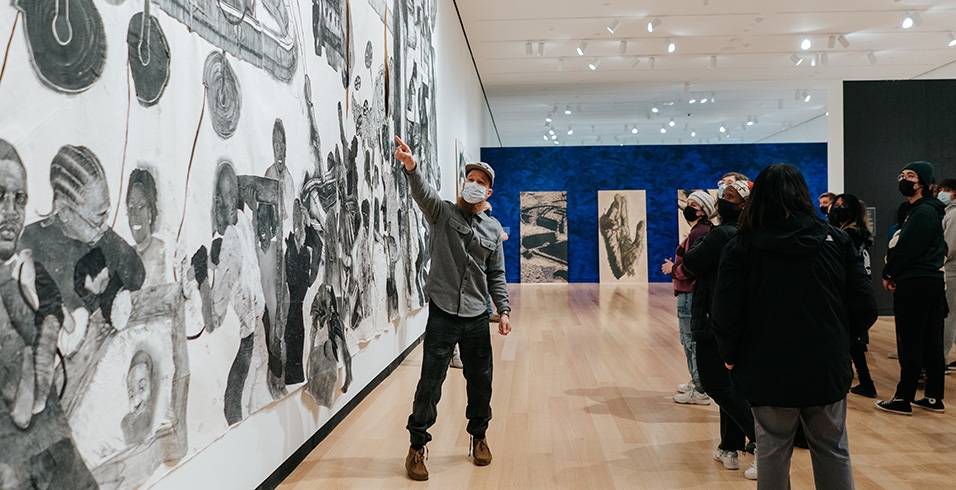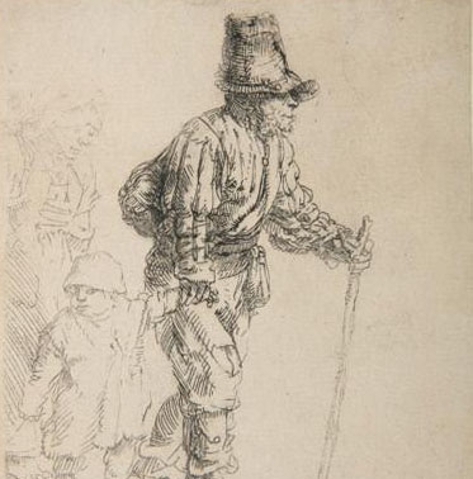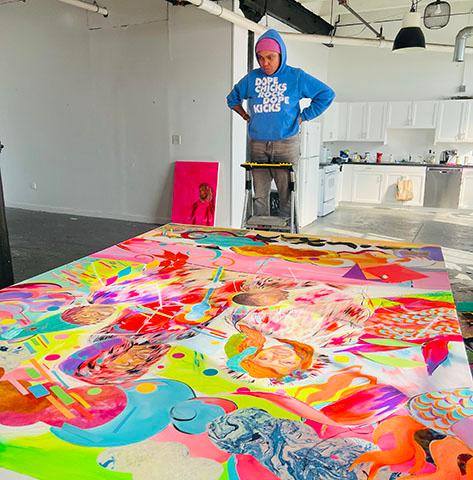Janelle Rodriguez

The centerpiece of our current exhibition Yashua Klos: OUR LABOUR is undoubtedly the 38-foot mural of the same title that depicts the artist’s newly discovered family from Detroit. Looking across this work, one sees a multitude of figures all dwarfed by the immense machinery surrounding them. Interspersing these industrial forms are a series of vines and flowers which provide a literal and figurative counterpoint to the rest of the mural’s imagery. For Klos, these floral elements represent the idea of growth and “Black resiliency” in the face of discriminatory social policies or architectures of confinement. The OUR LABOUR mural reminds us of the ways that nature—and hope—can bloom even in the smallest of cracks in concrete or the most challenging of situations, and it mirrors the way the OUR LABOUR exhibition came to fruition.
Several years ago, Klos originally signed onto a much smaller project with the museum, an exhibition around 1,500 square feet and slated for a February 2021 opening. As the initial wave of the pandemic forced the extended closure of the museum it became clear that our collaboration with the artist would be greatly impacted and would need to be reconsidered. Throughout this time, Klos was always confident that something beautiful would blossom out of those dark days and the OUR LABOUR exhibition is a verification of his prognosis. Over the course of monthly, virtual studio visits, I witnessed the artist utilize the additional twelve months of time to its absolute fullest. His ambition fueled the creation of a body of work that now occupies approximately 3,000 square feet and features imagery and content not present in his previous works.
As the artist’s idea for the exhibition expanded, so did our commitment to his vision, which will also manifest itself in the form of a publication documenting and contextualizing this period of Klos’s production. The catalog for OUR LABOUR will include contributions from LeRonn Brooks, Associate Curator for Modern and Contemporary Collections at the Getty Research Institute; Lauren Haynes, Senior Curator of Contemporary Art at the Nasher Museum of Art at Duke University; and the Wellin’s director and curator of the exhibition, Tracy L. Adler. Given the power of Klos’s family story and its relevance to broader American history, the creation of a catalogue to accompany the exhibition feels important and is just another example of how much the project has grown despite a very challenging environment.
Now that the exhibition has opened to the public, I’m most excited to witness the various engagements visitors have with the artist and his work. Throughout the pandemic Klos never stopped exhibiting in various group and solo exhibitions in the United States and Europe. However, his interactions with audiences have all but disappeared in the last two years and he has stated repeatedly how important it will be for him to hear about all of the reactions from students and faculty visiting the exhibition. For an artist like Klos, having an opportunity to understand what others are discovering in his work will help inform some of his future efforts in the studio. In this way, I always find gratification in knowing that our exhibitions at the Wellin work in two directions—the campus community benefits from viewing and discussing the work of an artist, but the artist also receives a valuable gift from the campus community in the form of feedback, interpretation, and even debate. Given that the OUR LABOUR exhibition deals so much with ideas of family and community, I find it poignant to reflect on the ways that the museum’s work connects so many people together right now.







